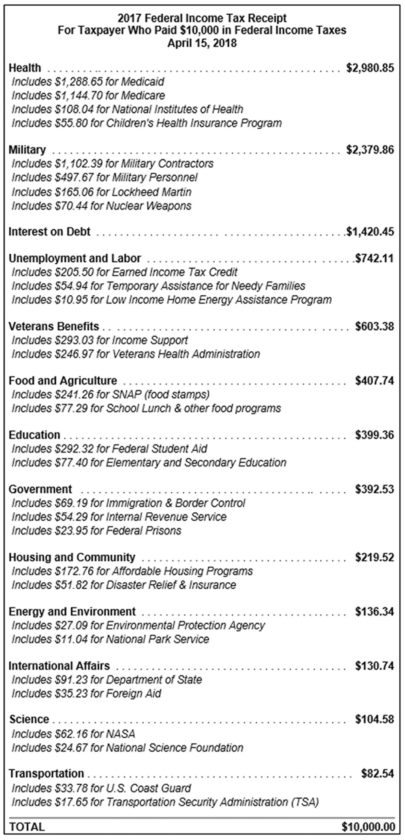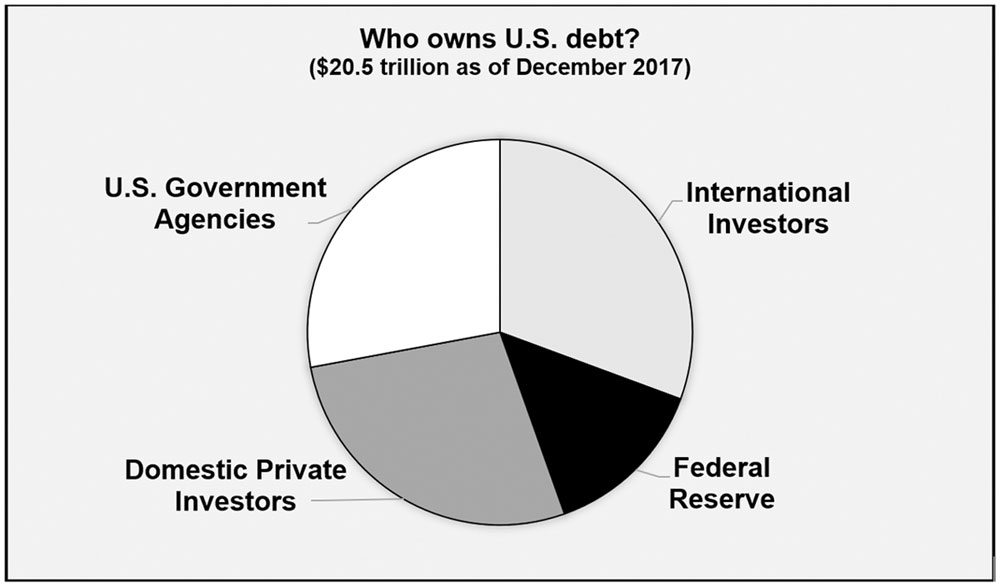What do you get for your income taxes?

A couple of weeks ago, this column covered the recent budget-busting tax-and-spending bills passed by Congress and how, in the midst of one of the longest economic expansions in history, Congress squandered an opportunity to reduce the size of the national debt relative to national income. Here are some more details on what you get for your tax dollars.
–
A tax receipt you can relate to
–
The enormity of the federal budget is meaningless to most if not all of us. The items included in the federal budget are often quoted in thousands of billions of dollars. What can you buy for a few billion dollars? Beats me.

To make those unfathomable numbers more meaningful, the National Priorities Project, which is a nonprofit, nonpartisan federal budget research organization, has an app on their web page that creates itemized “receipts” for taxpayers. NPP’s mission is “to make the federal budget accessible to the American public.” I accessed their app and created a receipt for the payment of $10,000 in 2017 federal income taxes. (See table.)
The NPP’s itemized tax receipts show 13 major categories of items you paid for with your 2017 taxes such as education, health care and military spending. It also shows 30 subcategories including federal student aid, Medicaid and nuclear weapons. About two-thirds of your tax dollars were spent on just three major categories including: (1) health care, (2) military and (3) interest on the federal debt. Note: NPP’s tax receipts exclude taxes paid into trust funds including Social Security and Medicare.
You can generate your own tax receipt using the NPP’s app at www.nationalpriorities.org/interactive-data/taxday, which is based on the Office of Management and the Budget’s public budget database. A similar app called Balancing Act, which is available at http://usa.v1.abalancingact.com/taxreceipt, generates receipts that include taxes paid to support the Social Security retirement and disability programs. Both apps generate similar receipts and show health care, defense and interest are among the top expenses of the federal government. The Obama administration had a similar app on the whitehouse.gov website that is no longer available.
–
Saddling future generations of taxpayers with debt
–
An often-expressed concern is whether future generations of taxpayers will inherit a crushing national debt from the current generation of spendthrifts. The National Debt Clock, for example, is an impressive electronic billboard in the Times Square area of NYC that displays the ever-increasing national debt as well as “your family’s share” of the debt, which is currently about $175,000.
Future generations of taxpayers will likely inherit a relatively large national debt from current generations, but that is a one-sided view of a two-sided issue. The other side of the issue is to whom payments on the debt are made. For every borrower who makes a payment on their debt, there is a lender who receives that payment. Future generations will inherit both our payables and our receivables. Currently, more than two-thirds of the U.S. national debt is owned by U.S. domestic interests.
As shown in the pie chart, much of our national debt is owned by U.S. government agencies such as the Social Security trust fund, as well as the Federal Reserve and various domestic private investors including U.S. corporations, mutual funds, pension funds, banks and insurance companies, among others.
The most troubling part of the U.S. debt is the debt owned by foreigners. Nearly one-third of the national debt is owned by foreign investors. The top five foreign holders of our national debt are in China, Japan, Ireland, Brazil and Cayman Islands. China and Japan are by far the largest holders of our national debt, with China holding almost 6 percent and Japan holding about 5 percent.
The bad news is the national debt is growing faster than our national income — faster than our ability to repay it. There is little good news in this story other than we owe much of our debt to ourselves.




